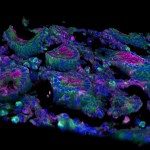Link to Pubmed [PMID] – 27469027
Link to DOI – S1567-1348(16)30302-110.1016/j.meegid.2016.07.012
Infect Genet Evol 2016 12; 46(): 324-332
An ideal model for HIV-1 research is still unavailable. However, infection of non-human primates (NHP), such as macaques, with Simian Immunodeficiency Virus (SIV) recapitulates most virological, immunological and clinical hallmarks of HIV infection in humans. It has become the most suitable model to study the mechanisms of transmission and physiopathology of HIV/AIDS. On the other hand, natural hosts of SIV, such as African green monkeys and sooty mangabeys that when infected do not progress to AIDS, represent an excellent model to elucidate the mechanisms involved in the capacity of controlling inflammation and disease progression. The use of NHP-SIV models has indeed enriched our knowledge in the fields of: i) viral transmission and viral reservoirs, ii) early immune responses, iii) host cell-virus interactions in tissues, iv) AIDS pathogenesis, v) virulence factors, vi) prevention and vii) drug development. The possibility to control many variables during experimental SIV infection, together with the resemblance between SIV and HIV infections, make the NHP model the most appropriate, so far, for HIV/AIDS research. Nonetheless, some limitations in using these models have to be considered. Alternative models for HIV/AIDS research, such as humanized mice and recombinant forms of HIV-SIV viruses (SHIV) for NHP infection, have been developed. The improvement of SHIV viruses that mimic even better the natural history of HIV infection and of humanized mice that develop a greater variety of human immune cell lineages, is ongoing. None of these models is perfect, but they allow contributing to the progress in managing or preventing HIV infection.

